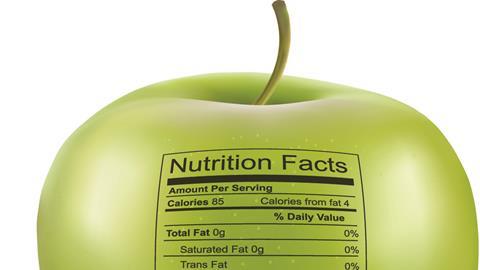Attitudes about malnutrition must change if care for patients with respiratory conditions is to become more efficient, writes Claire Read
It is not unusual for chronic obstrructive pulmonary disease patients to be termed “frequent flyers”. But when people use that phrase to describe Russell Winwood, they’re not referring to regular accident and emergency visits for exacerbations of his condition. They’re using it in its original sense.

Mr Winwood, diagnosed with chronic obstructive pulmonary disease back in 2011, has flown all over the world to compete in exactly the sort of athletic events to which he was dedicated pre-diagnosis.
He considers himself to be living well with COPD and says his ability to do so is not only down to medical interventions but also to lifestyle choices – including careful attention to diet.
“I take four lots of inhalers every day and that’s fine. But I think we can also look at things we can do in a practical sense that can change our situation,” comments Mr Winwood, who has tailored his nutritional intake over the past year with a view to better living with his condition. “Good nutrition is important,” he argues.
Certainly the statistics suggest major room for improvement when it comes to the nutritional status of COPD patients in general.
The outcome of malnutrition in COPD patients tends to be consistent: spiralling ill health and increased health costs
Some 1.2 million people in the UK now have a diagnosis of COPD – numbers are continuing to rise – and the condition is the second most common cause of emergency admissions to hospital. Of those inpatients with COPD, 30 to 60 per cent are thought to be malnourished. For outpatients, it’s 10 to 45 per cent.
The outcome of malnutrition in COPD patients tends to be consistent: spiralling ill health and increased health costs.
Explains consultant dietitian Anne Holdoway: “The [malnourished] patient is prone to infections, or an exacerbation of the COPD. That may lead to a hospital admission, which obviously costs money. In the presence of anxiety, infection and breathlessness, nutritional intake is often further hampered. The individual ends up in a downward spiral, becoming more malnourished, and so by the time they are recovering or come out of hospital, they may be weak, breathless, fatigued and be less able to cope.”
Reduced appetite
COPD is far from the only respiratory condition associated with malnutrition risk. Mhairi Donald, a consultant dietitian at Brighton and Sussex University Hospitals Trust, explains lung cancer patients can also experience real problems in taking on adequate nutrition.
“They develop a whole range of symptoms that may affect oral nutrition – so some may become breathless, they may become more tired, they may develop some pain. And then changes in hormones as a result of the disease often reduce the appetite as well.”
Research shows that lung cancer patients with weight loss often fail to complete the full number of chemotherapy cycles initially prescribed for them.
‘They may develop some degree of oesophagitis [where the tube which carries food from the mouth to the stomach becomes inflamed and sore], so unless someone recognises that might happen [and intervenes], the chances are they’re going to become undernourished, dehydrated’
“So you can be in a situation where you’re starting off a very expensive treatment, and actually not getting the patient through it because they’ve already had significant weight loss,” explains Ms Donald.
“We know for example with radiotherapy that 30 per cent of our lung cancer patients will lose weight on the treatment.
“And they may develop some degree of oesophagitis [where the tube which carries food from the mouth to the stomach becomes inflamed and sore], so unless someone recognises that might happen [and intervenes], the chances are they’re going to become undernourished, dehydrated, may need an admission to hospital and the chances are they will need more pain control. So I think malnutrition is something commissioners do need to be thinking about.”
Challenging assumptions
For Rachel Pryke, that will involve overcoming misperceptions about poor nutrition in patients with respiratory disease. “Our perception of seeing malnourishment as an issue is blurred by our assumption that it’s normal if you have these conditions,” argues Dr Pryke, a practising GP in Redditch, Worcestershire, and a clinical adviser on nutrition to the Royal College of General Practitioners.
“So I’d suggest [we need to change] attitudes, and to challenge the assumption that this is what we would expect.”
Ms Donald agrees, and hopes such preconceptions might be addressed in part by pathway documents for nutrition in COPD and lung cancer patients. The former was initially published in 2014 and the latter in 2016 – the result of work by a group of experts which included Ms Donald.
“In a way, the pathway is saying, no, malnutrition isn’t a given in lung cancer patients,” she suggests. “It says let’s look at what we can do to support this group, let’s define who they are, define those who have got more of a problem, and see what we can do to help. It’s acknowledging that there is potential to support this group.”
The pathways can also provide valuable insight for healthcare professionals who may have limited expertise in nutrition. “One thing that comes out in much of the work I do is the lack of nutrition education on the curriculum for doctors and nurses,” reports Ms Holdoway.
‘I do think there are probably opportunities for commissioners, for CCGs, to look at slightly more novel approaches to dietetic management for these patients’
“Such pathways, which are put together by a group of experts who have the nutrition knowledge, can basically provide a walkthrough guide for healthcare professionals to assess the presence of nutritional issues when faced with a patient with COPD or lung cancer – if they are at nutritional risk the pathways can help identity what can be done to help.”
As well as making such pathways easily available, Ms Holdoway argues CCGs could valuably consider new ways to provide dietetic expertise in the community. “I understand there are not enough dietitians to cover every condition, and for every patient to be able to see a dietitian the moment they have dietary issues.
“But there is really great work looking at the use of telephone helplines, or of the use of technology for patients to record the latest about their weight and appetite, with alerts sent to healthcare professionals when action is needed. I do think there are probably opportunities for commissioners, for CCGs, to look at slightly more novel approaches to dietetic management for these patients,” she concludes.
Malnutrition should not be inevitable – here’s what we can do
A few years back, the National Institute for Health and Care Excellence considered areas of possible financial savings for the NHS. In 2016 it concluded that the identification and treatment of malnutrition had the second highest potential to achieve this.
This was a fact emphasised in NHS England’s 2015 guidance on the effective commissioning of nutrition and hydration. That guidance urged “all commissioners to view nutrition and hydration as a priority”.

Yet the reality is that malnutrition is still too common an issue in our hospitals and our communities. Too many people are not getting the nutrients they need, and becoming weak and less able to deal with illness as a result.
Weight loss does not have to be an inevitable consequence of serious respiratory illness
The problem is particularly acute for people with serious respiratory conditions such as chronic obstructive pulmonary disease (COPD) or lung cancer. It is extremely common for patients with these diseases to be poorly nourished – estimates suggest up to 60 per cent of inpatients with COPD may be malnourished.
The potential consequences are serious. A patient with COPD who is not getting enough nourishment may be at greater risk of exacerbations and hospital admissions: it is notable that COPD is now the second most common cause of emergency admissions.
For a lung cancer patient, losing weight means planned treatments may have to be delayed or cancelled. This could mean a sub-optimal dose of chemotherapy, for instance.
Ensuring uniformity of care
In short, malnutrition in those with lung cancer or COPD leads to big increases in healthcare costs and big decreases in the quality of patient experience.
It does not have to be this way. While both conditions can make it harder to take on adequate nutrition, intervention at an early stage can help reduce the risk of patients becoming malnourished – and so improve their general wellbeing. Weight loss does not have to be an inevitable consequence of serious respiratory illness.
That is underscored by nutritional pathway documents created for COPD and lung cancer. These evidence-based pathways support healthcare professionals in managing malnutrition in these conditions, showing exactly what steps to take if there are concerns about an individual’s nutritional intake.
When such pathways are used, they can help ensure uniformity of care – significantly, lung cancer and COPD are both highlighted by NHS England’s RightCare programme as areas ripe for the elimination of variation. By ensuring any problems with nutrition are identified early, and the right action taken, patient outcomes can be improved and costs reduced.
Cem Kucukcan is general manager, Nutricia Advanced Medical Nutrition UK and Ireland
Downloads
Ing 43633 00973
Other, Size 5.99 mbIng 43633 00973
Other, Size 5.99 mb



























No comments yet